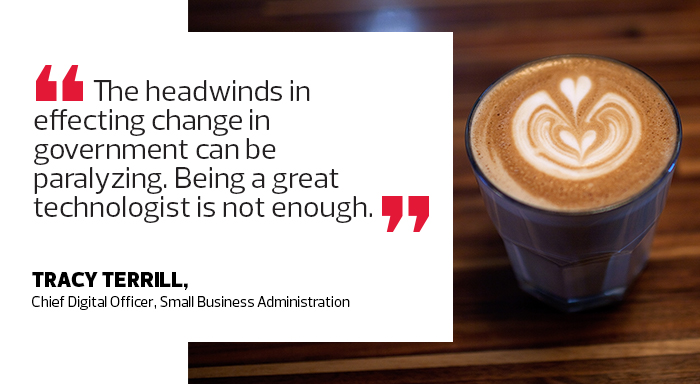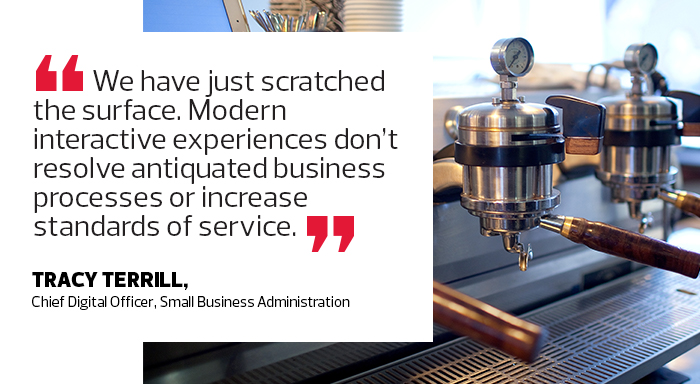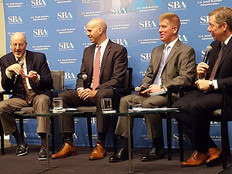SBA Chief Digital Officer Tracy Terrill Shakes Up Agency's Tech Culture
When Tracy Terrill came to the Small Business Administration last year, he began his job as its inaugural chief digital officer with a hefty to-do list of citizen-facing and back-end systems projects.
Predominant among his tasks: Establish the Office of Digital Service, build a team and define its roadmap for the next three years. Reimagine how SBA engages with the 20 million entrepreneurs and small businesses that seek assistance online annually. Temporarily oversee the CIO Office, while recruiting a new C-suite tech team, including a CIO, chief information security officer and chief technology officer. And expedite the agency’s migration to the cloud while improving its cybersecurity posture.
Coming off eight years as CTO at LegalZoom, Terrill has worked with and at startups, and SBA wanted to tap that nimbleness when retooling.
FedTech Editorial Director Vanessa Jo Roberts chatted with Terrill about the fast-track approach he’s taken to his role and the future of SBA Digital Service.
FEDTECH: I notice you specifically say Digital Service as opposed to Services when you speak of your team.
TERRILL: While it might seem subtle, the nuance of the word “service” rather than “services” relates to our organizing principle. We recruit technologists to join for “tours of service” of two to four years. Our view is that innovation in government requires a diversity of technology experiences that come from people having worked in dynamic organizations — often in industry.
We initially received skepticism from career leadership suggesting it would be difficult to attract temporary employees. We have found the opposite to be true and have been overwhelmed with interest. Most tech professionals today do not view their career as a single lifelong job; they view it in multiyear segments to remain relevant.
FEDTECH: Does this mean striking at the heart of the culture of how agencies have worked for years — in some cases, even hundreds of years?
TERRILL: Cultural change happens over time. Certainly, I had grand dreams that we could do all of this quickly and people would suddenly be on board.
Working in industry, it was easier to get everyone on the same page quickly. This is going to be a multiyear effort, and a change of culture. But it’s one that the government can’t not do.
We’re at an inflection point: People are demanding to interact with the government securely and with ease at a time when the federal government spends upward of 80 percent of its technical budget maintaining faulty legacy systems. We can’t afford to wait and see if our past approach to technology will serve our future. We know the answer.
We’re seeing pieces — people getting very excited about it and beginning to think differently within agencies.

FEDTECH: Your teams seem to have made significant progress over the past year. What has been the key to driving success?
TERRILL: The quick answer: executive support at the highest levels and an amazing team. Our cabinet leader, SBA Administrator Maria Contreras-Sweet, created a path for our success. Modern technology, new management methodologies and recruiting talent from industry were instrumental to her vision of the SBA being “smart, bold and accessible.” She also knew it would take other agency changes to make it possible.
To that end, she appointed the first-ever chief innovation officer, Arthur Plews. A lawyer by training and operations guru by trade, Arthur has been an incredible force. Like me, he is motivated more by asking, “Why not?” than by accepting the status quo. Innovation can be defined many ways; Arthur has defined the role by helping shape our approach to serving small business as well as improving agency processes to achieve rapid results.
FEDTECH: The Office of the CIO and Digital Service report separately to agency leadership, but how do you foresee the two teams collaborating?
TERRILL: OCIO and the Digital Service will collaborate closely — and may work on projects together — but will remain separate organizations with separate reporting structures. This is by design.
It is no secret that agencies are plagued with aging technology and legacy systems. They face the dilemma of how to deliver new technology in support of the mission while carrying the burden of maintaining old technology.
Our immediate path forward is to divide and conquer. The Digital Service will focus mainly on citizen-facing technology and its supporting systems, while OCIO will focus on remediating aged systems, improving baseline technology and strengthening cybersecurity measures. It is my hope that in a few years there will be no need for separate teams, but we aren’t there yet.
FEDTECH: Can you talk about the experience that your staff brings to the table, and what that means for SBA?
TERRILL: The people that we have recruited are folks who have done similar work in industry with proven success. They view things from a user-centric design perspective and build things that people have an innate understanding of how to use. They believe the way a product or service is delivered is as important as how shiny it looks on a website. You can often pick them out at larger agency meetings as they will refer to end users as “customers.”
They’re excited about digging in and making things happen, and that’s driven in part by the fact that they are only here for two to four years at a time.
Our view is that innovation in government requires a diversity of technology experiences that come from people having worked in dynamic organizations — often in industry. Most technologists do not view their careers as single, lifelong jobs; they view their careers in multiyear segments so that they can continuously learn and remain relevant.
I may have erred in making all of this sound easy. And the story risks being heard as some magical solution: Bring successful people from industry into government and instantly solve everything.
The headwinds in effecting change in government can be paralyzing. Being a great technologist is not enough. You need a strike team composed of the best procurement officers, personnel specialists, business analysts, lawyers and agency leaders. They all must be interested in challenging the status quo — in a way that is respectful with a sense of urgency that avoids resentment. It’s tricky, but intrinsically rewarding when it happens.
FEDTECH: What’s crucial if this digital service approach is to take hold across government?
TERRILL: Without question, the success of digital service teams across the federal government will depend on where they report.
Look at the Defense Department. The DOD chief digital officer reports directly to Defense Secretary Ash Carter. The Defense Digital Service story is extraordinary. I recall when I first heard the team’s plan to sponsor a paid bounty to ethically hack the unclassified network perimeter of DOD that I was suspicious.
How would they manage the procurement implications of paying a dark web hacker? How could they ensure immunity to a hacking community already skeptical of the government’s reach? How would the traditional technology organizations take to having their technology tested in such a public manner? During their public briefing, I was far more mesmerized on how they were able to make the bureaucracy accommodate such a radical idea for government than on the details of the vulnerabilities identified.
I left inspired. In bureaucratic parlance, I had witnessed a miracle.
Much like at DOD, I have a close reporting relationship with Administrator Contreras-Sweet, which has been key to making SBA’s Digital Service a success. I’m also hopeful that the next White House will continue President Obama’s charge in recruiting and calling for technologists to serve our nation through the U.S. Digital Service, agency digital service teams, and countless other technology and engineering roles across the federal government.

FEDTECH: Your office’s long-term goal is to modernize engagement between SBA and entrepreneurs. Why is that such a critical mission?
TERRILL: Regardless of political party, everyone agrees that small business is good. It is not only good; it helps drive our economy.
The United States has approximately 28 million small businesses that help fuel America’s economy. We have had 73 months of historic consecutive job growth, with two-thirds of these jobs coming from new business startups and small business growth.
Behind the scenes is the Small Business Administration. Since its founding by President Eisenhower, SBA has provided a variety of services, principally counseling and capital loan guarantees to small businesses. As the agency celebrates its 60th year of service, it’s important to assess how effectively we are reaching our constituency: entrepreneurs and small business owners.
Our reach is impressive. By the end of 2016, SBA and its partners will have had over 1 million in-person interactions with our constituency. It will exceed 20 million unique online interactions.
Like many agencies, SBA has struggled to keep pace with technology and evolve with digital trends. The current agency website meets the basic needs of providing information but stops short of custom, experience-driven interactions. It was designed to reflect the SBA organization chart with excessive use of acronyms and far too many words. A lot of it means nothing to the entrepreneur who wants to open a cafe or start an online business.
Administrator Contreras-Sweet recognized these shortcomings, which led to the creation of our Digital Service and my appointment as chief digital officer.
FEDTECH: What is the Digital Service working on now, and what do you anticipate it will be working on over the next few years?
TERRILL: We have a number of initiatives under way, beyond reimagining our online presence. The team is also improving the application and annual certification process for disadvantaged businesses to be considered for federal contracts. Efforts are underway to create online geospatial mapping to identify historically underserved business, or HUB, zones to increase awareness of opportunities in these communities.
We have just scratched the surface. Modern interactive experiences don’t resolve antiquated business processes or increase standards of service. I anticipate the Digital Service will be instrumental in driving deeper change throughout SBA in how it serves entrepreneurs, small businesses, our counseling network and our lending partners. And we will begin to drive home that we really do think of our constituents as customers.
FEDTECH: Speed to market just keeps getting faster. Given that, how important is technology to the success of any small business or startup?
TERRILL: While there are 28 million businesses in America, they’re not all tech startups. Many do not think that technology is imperative to their business. But it is.
Today, if you’re going to open up a coffee shop, you’re not going to buy an old cash register that just adds numbers, right? Ten years ago if you wanted a point-of-sale system, you’d have to go buy something that cost $100,000. Now, you can buy an iPad and pay a few dollars a month, and you get something that’s even better than that $100,000 system.
I recently found myself at a yard sale and noticed they were accepting payments with a phone and card reader. I’m knowledgeable about this technology, and it had never crossed my mind just how pedestrian credit card processing has become.
Twenty-five years ago, charging a card was medieval by today’s standard. Remember that heavy contraption that you’d set the credit card in, place the triplicate carbon copy receipt across and run the heavy arm over to imprint the card number on the receipt? If you don’t remember that, you’re probably not alone. I’m guessing by the youth of the purveyor at the yard sale, she didn’t either.

Another quick example: I recently thought I had lost a shirt at my dry cleaner. Within minutes, using a radio frequency identification tag, the clerk was able to find my shirt hanging on the wrong conveyer. I was delighted by the ease of resolving what could have been a bad experience.
These two examples are emblematic of how all businesses must embrace technology. Not only is it key to customer satisfaction, but it also leads to increased business. I have told no less than 20 people (and now many more) of how well that dry cleaner was able to find my missing shirt. People love a bad customer service story that ends in delight.
Choosing not to employ the wide array of technology and services available puts your business at a significant disadvantage. A lot of people come to SBA for information on these types of solutions. In response, we’ve launched the Small Business Technology Coalition as an educational resource. The coalition is currently composed of 22 companies (and growing) that have made a commitment to provide education about their products and services, without aggressively marketing the small businesses and startups they mentor or asking for a sale.
FEDTECH: For many small businesses, investment in IT is a hurdle. How can SBA help them figure out return on investment?
TERRILL: A lot of this is about perception. Sometimes, businesses don’t understand that many of these tools are within range.
Ten years ago, if you were a small business and wanted to use a customer relationship management system, it was financially and technically challenging. Would you implement a million-dollar solution for your small store? Probably not.
Now, you have a range of options that won’t break the bank. You simply can’t compete if you’re not using modern tools and technologies.








